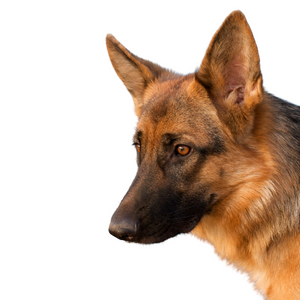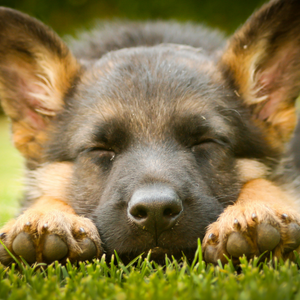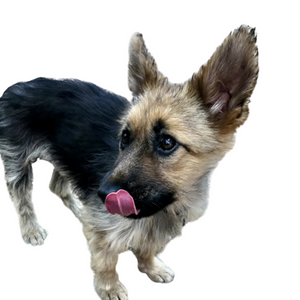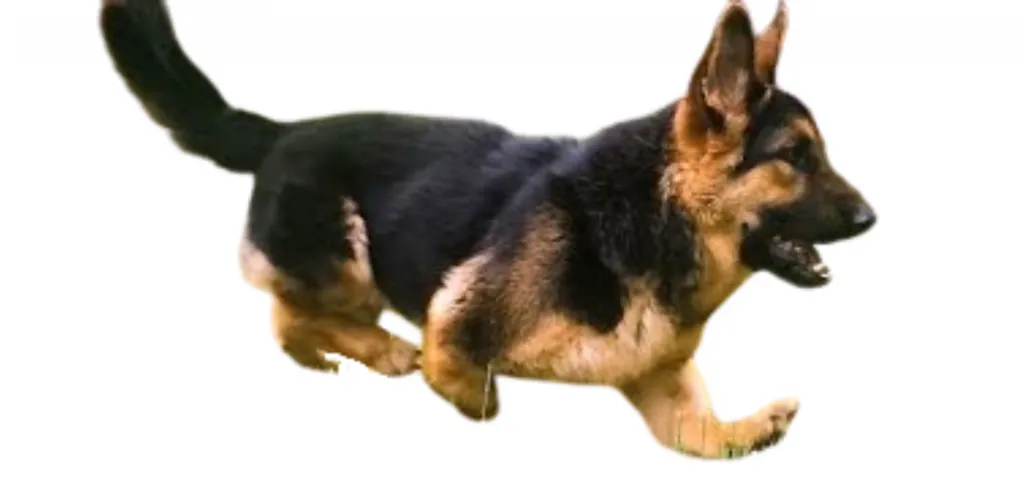German Shepherd Dwarfism: The first thing to point out is dwarf German Shepherds are not a breed. German Shepherds with dwarfism have a genetic disorder.
German Shepherds are officially recognized as a medium to large breed. The average size for the GSD breed is around 24-26 inches in height and 50-90 pounds in weight. However, in some rare cases, German Shepherds can be smaller. For more information on German Shepherd sizes please see this article here.
Typically, a German Shepherd with dwarfism may reach a height of 18-22 inches and a weight of 30-50 pounds. However, it’s important to note that these are averages and the size difference can vary depending on the severity of the Dwarfism.
Important:
Not all small German Shepherds are necessarily affected by Dwarfism, they could be simply small due to other factors such as genetics, nutrition, or other health conditions.
In this article, we will look at what causes dwarfism in German Shepherds, the early signs and symptoms, and how this affects the German Shepherd.
What is dwarfism in German Shepherds?
Dwarfism in German Shepherds, also known as Pituitary Dwarfism, is caused by a genetic mutation that affects the production of growth hormone by the pituitary gland.
This leads to a deficiency in growth hormone, which results in the dog being smaller in size than the average German Shepherd.

What are the early signs and symptoms of a German Shepherd with dwarfism?
The early signs of Dwarfism in German Shepherds can be subtle and may not be immediately obvious. Some common early signs include:
- Delayed growth: Puppies with Dwarfism may be smaller than their litter mates and may not reach their expected growth milestones at the same time.
- Small size: Adult German Shepherds with Dwarfism may be smaller in size than normal German Shepherds of the same age.
- Delayed sexual maturity: Dogs with Dwarfism may have delayed sexual maturity, which means they may not reach puberty until later than normal German Shepherds.
- Changes in bone structure: Dwarfism can affect the structure of the bones, which can cause the dog to have a short, stubby appearance.
- Delayed teeth development: Dogs with Dwarfism may have delayed tooth development, which can cause them to have smaller teeth or a smaller jaw.
- Weakness: Dwarfism can cause weakness and muscle atrophy, which can affect the dog’s overall mobility and make them appear weak or frail.
It’s important to note that not all German Shepherds with Dwarfism will show all these signs and symptoms, and some may not show any signs until later in life. Consult with a veterinarian who is familiar with this condition in German Shepherds, they will be able to examine your dog and provide a diagnosis
How common is dwarfism in German Shepherds?
The frequency of Dwarfism in German Shepherds is not well documented; however, it is considered to be a rare genetic disorder.
Pituitary dwarfism is inherited in an autosomal recessive manner, this means that the dog must inherit two copies of the mutated gene (one from each parent) to develop the disorder. A German Shepherd dog that is a carrier of the gene (has one copy) will not have the disorder but may pass the gene to its offspring if it is bred with another German Shepherd which also carries the mutated gene.
When two carriers are bred together, there is a 25% chance that each puppy will be affected by Dwarfism, a 50% chance that the puppy will be a carrier, and a 25% chance that the puppy will not have the gene or be affected.
It’s important to note that breeding dogs affected with Dwarfism is not recommended, as it can spread the condition to future generations. It’s recommended to have the potential breeding dogs tested for the disorder before breeding them.
It’s always recommended to do research and consult with a reputable breeder who can provide information about the health and genetic history of the dogs they have available.

What to do if you are worried your German Shepherd may have dwarfism?
It’s understandable that you may be concerned if you suspect your German Shepherd may have Dwarfism.
The best course of action would be to consult with a veterinarian who is familiar with this condition in German Shepherds. They will be able to examine your dog and provide a diagnosis. If your dog is diagnosed with Dwarfism, the vet will be able to provide you with information on how to manage the condition and care for your dog.
While Dwarfism can affect the size and lifespan of a German Shepherd, with proper care and management, affected dogs can still have a good quality of life. It is important to note that breeding dogs affected with Dwarfism is not recommended, as it can spread the condition to future generations.
The Saartje Foundation for pituitary dwarfism in dogs is a ‘not for profit’ organization specializing in German Shepherds with pituitary dwarfism.
How to care for a German Shepherd with dwarfism:
If your German Shepherd has been diagnosed with Dwarfism, there are a few things you can do to ensure they have a good quality of life:
- Feed them a high-quality, nutrient-dense diet to help them maintain a healthy weight and support their overall well-being.
- Provide them with regular exercise and playtime, but be mindful of their smaller size and adjust the intensity and duration of their activity accordingly.
- Regular veterinary check-ups will be important to monitor the dog’s overall health.
- Provide them with a comfortable, safe environment that is easy for them to navigate, as some German Shepherds with Dwarfism may have difficulty with stairs or high surfaces.
- Provide them with appropriate medical treatment such as hormone replacement therapy (HRT) if recommended by the veterinarian.
- Be mindful of the dog’s life expectancy as Dwarfism German Shepherds have a shorter lifespan than normal German Shepherds.
It’s important to remember that while Dwarfism can affect the size and lifespan of a German Shepherd, with proper care and management, affected dogs can still have a good quality of life.
It’s always best to consult with a veterinarian who is familiar with this condition in German Shepherds, they will be able to provide you with the best advice on how to care for your dog.
What is the life expectancy of a german shepherd with dwarfism?
The life expectancy of a German Shepherd with Dwarfism can vary depending on the severity of the condition and the overall health of the individual dog. Generally, German Shepherds with Dwarfism have a shorter lifespan than normal German Shepherds.
Dwarfism can cause a number of health complications, such as joint problems, respiratory issues, and weakened immune systems, which can affect the dog’s overall health and shorten its lifespan.
Some studies show that life expectancy for German Shepherds with Dwarfism can be about 5-7 years, but it could be shorter or longer depending on the individual dog.
It’s important to note that with proper care and management, affected dogs can still have a good quality of life, even if they have a shorter lifespan. Regular veterinary check-ups and appropriate medical treatment can help to extend the dog’s life and improve its overall well-being.
It’s always best to consult with a veterinarian who is familiar with this condition in German Shepherds, they will be able to provide you with the best advice on how to care for your dog and what to expect regarding their life expectancy.

What causes a german shepherd to be born with dwarfism?
German Shepherd Dwarfism, also known as Pituitary Dwarfism, is caused by a genetic mutation that affects the production of growth hormones by the pituitary gland. This leads to a deficiency in growth hormone, which results in the dog being smaller in size and having a shorter lifespan than normal German Shepherds.
Dwarfism is inherited as an autosomal recessive trait, which means that both parents must carry the gene for the condition for it to be passed on to their offspring. Dogs that are carriers of the gene for Dwarfism do not show any symptoms of the condition but are able to pass the gene on to their offspring.
When two carriers are bred together, there is a 25% chance that each puppy will be affected by Dwarfism, a 50% chance that the puppy will be a carrier, and a 25% chance that the puppy will not have the gene or be affected.
It’s important to note that breeding dogs affected with Dwarfism is not recommended, as it can spread the condition to future generations. It’s recommended to have the potential breeding dogs tested for the disorder before breeding them.
Early signs a german shepherd has dwarfism:
The early signs of Dwarfism in German Shepherds can be subtle and may not be immediately obvious. Some common early signs include:
- Delayed growth: Puppies with Dwarfism may be smaller than their litter mates and may not reach their expected growth milestones at the same time.
- Small size: Adult German Shepherds with Dwarfism may be smaller in size than normal German Shepherds of the same age.
- Delayed sexual maturity: Dogs with Dwarfism may have delayed sexual maturity, which means they may not reach puberty until later than normal German Shepherds.
- Changes in bone structure: Dwarfism can affect the structure of the bones, which can cause the dog to have a short, stubby appearance.
- Delayed teeth development: Dogs with Dwarfism may have delayed tooth development, which can cause them to have smaller teeth or a smaller jaw.
- Weakness: Dwarfism can cause weakness and muscle atrophy, which can affect the dog’s overall mobility and make them appear weak or frail.
It’s important to note that not all German Shepherds with Dwarfism will show all these signs and symptoms, and some may not show any signs until later in life. Consult with a veterinarian who is familiar with this condition in German Shepherds, they will be able to examine your dog and provide a diagnosis
What is a pituitary gland in german shepherds?
The pituitary gland, also known as the “master gland,” is a small endocrine gland located at the base of the brain in all animals, including German Shepherds. It plays a vital role in regulating the body’s endocrine system by producing and secreting hormones that control various bodily functions, such as growth, metabolism, and reproduction.
In German Shepherds, the pituitary gland is responsible for producing growth hormone, which stimulates the growth and development of bones, muscles, and other tissues. When the pituitary gland does not function properly and does not produce enough growth hormone, it can lead to Dwarfism, a condition that affects the growth of German Shepherds.
In addition to growth hormone, the pituitary gland also produces other hormones such as thyroid-stimulating hormone, adrenocorticotropic hormone, luteinizing hormone, follicle-stimulating hormone, and prolactin. These hormones play important roles in regulating metabolism, thyroid function, stress response, and reproductive function.
Problems with the pituitary gland can be caused by various factors such as tumors, genetic defects, injury or inflammation and can lead to a variety of health issues including Dwarfism and other hormonal imbalances. In such cases, it’s best to consult with a veterinarian who is familiar with this condition, they will be able to examine the dog and provide a diagnosis and appropriate treatment options.
What tests are done to see if your german shepherd has dwarfism?
There are several tests that can be done to determine if a German Shepherd has Dwarfism. These include:
- Physical examination: A veterinarian will perform a physical examination of the dog and compare the dog’s size and proportions to those of a normal German Shepherd of the same age.
- Radiography: X-rays can be used to evaluate the dog’s bone structure and to determine if there are any abnormalities that may be indicative of Dwarfism.
- Blood hormone tests: A blood test can be done to measure the levels of growth hormone in the dog’s blood. Low levels of growth hormone can indicate Dwarfism.
- Genetic testing: Genetic testing can be done to determine if the dog carries the gene for Dwarfism. Genetic testing can also be done on the parents of the dog to determine if they are carriers of the gene for Dwarfism.
It’s important to note that not all German Shepherds with Dwarfism will show all the signs and symptoms, and some may not show any signs until later in life. Therefore, testing is important to confirm the diagnosis and make sure that the breeding of German Shepherds is done responsibly to reduce the spread of the disorder.
It’s always best to consult with a veterinarian who is familiar with this condition in German Shepherds, they will be able to provide you with the best advice on how to test your dog and what to expect with the results.

Can you treat dwarfism in German Shepherds?
Dwarfism in German Shepherds is a genetic disorder caused by a deficiency in growth hormone, which is produced by the pituitary gland. Unfortunately, there is no cure for Dwarfism and it cannot be reversed.
However, there are treatment options that can help to manage the condition and improve the dog’s overall quality of life. These include:
- Hormone Replacement Therapy (HRT): HRT can help to increase the levels of growth hormone in the dog’s body and can improve the dog’s growth and development.
- Nutritional support: Feeding your German Shepherd a high-quality, nutrient-dense diet can help to support their overall well-being and maintain a healthy weight.
- Physical therapy: Regular exercise and playtime can help to maintain muscle tone and mobility, but it’s important to be mindful of your dog’s smaller size and adjust the intensity and duration of their activity accordingly.
- Regular veterinary check-ups: Regular veterinary check-ups are important to monitor the dog’s overall health and address any complications that may arise.
It’s important to note that Dwarfism can cause a number of health complications, such as joint problems, respiratory issues, and weakened immune systems. With proper care and management, however, affected dogs can still have a good quality of life.
It’s always best to consult with a veterinarian who is familiar with this condition in German Shepherds, they will be able to provide you with the best advice on how to care for your dog and what treatment options are available.
The daily life of a german shepherd with dwarfism:
The daily life of a German Shepherd with Dwarfism may be slightly different from that of a normal German Shepherd, but with proper care and management, affected dogs can still have a good quality of life.
Here are a few things to keep in mind when caring for a German Shepherd with Dwarfism:
- Feeding: Feed your German Shepherd a high-quality, nutrient-dense diet to help them maintain a healthy weight and support their overall well-being.
- Exercise: Regular exercise and playtime are important to maintain muscle tone and mobility, but it’s important to be mindful of your dog’s smaller size and adjust the intensity and duration of their activity accordingly.
- Regular veterinary check-ups: Regular veterinary check-ups are important to monitor the dog’s overall health and address any complications that may arise.
- Medication: If hormone replacement therapy is prescribed, it will be necessary to give the dog the medication on schedule as directed by the veterinarian.
- Special considerations: Be mindful of the dog’s size and provide them with a comfortable, safe environment that is easy for them to navigate, as some German Shepherds with Dwarfism may have difficulty with stairs or high surfaces.
- Life expectancy: Be mindful of the dog’s life expectancy as Dwarfism German Shepherds have a shorter lifespan than normal German Shepherds.
It’s important to remember that while Dwarfism can affect the size and lifespan of a German Shepherd, with proper care and management, affected dogs can still have a good quality of life. It’s always best to consult with a veterinarian who is familiar with this condition in German Shepherds, they will be able to provide you with the best advice on how to care for your dog.
is dwarfism in German Shepherds caused by the same thing as dwarfism in humans?
Dwarfism in humans and in German Shepherds is caused by different things. Dwarfism in humans is a genetic disorder that affects growth and development and can be caused by a variety of genetic mutations.
One genetic disorder which can affect both Humans and German Shepherds along with other species is Chondrodysplasia.
Chondrodysplasia is a genetic disorder that affects the development of cartilage and bone in both humans and animals, including German Shepherds. This disorder can cause various skeletal deformities, such as shortened legs, bowlegs, and a shortening of the spine, which results in a short, stubby appearance.
In humans, chondrodysplasia is a general term that describes a group of inherited disorders characterized by abnormal growth and development of the skeleton. There are more than 200 different types of chondrodysplasia that can affect humans, some of them are caused by a deficiency in growth hormone while others are caused by defects in other hormones or in the bones and cartilage.
In dogs, chondrodysplasia is also a genetic disorder that affects the development of cartilage and bone, it’s caused by different genetic mutations, and it can lead to various skeletal deformities, such as shortened legs, bowlegs, and a shortening of the spine.
Different breeds of dogs can be affected by different types of chondrodysplasia, Chondrodysplasia is a genetic disorder that affects the development of cartilage and bone in animals, and it can occur in various breeds of dogs, including German Shepherds, Dachshunds, Basset Hounds, and Corgis.
- Dachshunds: Dachshunds are a breed of dog that is known to have a form of chondrodysplasia called “dachshund dwarfism.” This condition causes their short legs and elongated spine.
- Basset Hounds: Basset Hounds are also prone to chondrodysplasia, which causes their short legs and long spine, which gives them their distinctive hound-like appearance.
- Corgis: Corgis are also known to be affected by chondrodysplasia, which gives them short legs and long body.
- German Shepherds: German Shepherds can also be affected by chondrodysplasia, which is known as Skeletal Dysplasia 2 (SD2) or Osteochondrodysplasia (OCD), which causes various skeletal deformities, such as shortened legs, bowlegs, and shortening of the spine.
It’s important to note that while the disorder has similarities in both species, the specific causes and effects can differ, and they are treated differently. It’s always best to consult with a veterinarian or a medical professional that is familiar with this condition in the species you are concerned about.

